Have you decided to get rid of ants in your summer cottage and don’t know how to do it? There are proven ways to combat these insects.
| Content:
|
|
The more numerous the ant colony, the greater the damage from its vital activity. |
Is it necessary to fight ants that have settled on the site? The answers to this question are the most contradictory. Some people are categorically against the destruction of “useful” ants. But gardeners and vegetable gardeners, faced with the consequences of vigorous ant activity, are ready to rid their plots of ants by any means necessary. Apparently it all depends on the degree of damage caused by these insects.
Ants on a summer cottage. Benefit and harm.
Most often in the garden and vegetable garden you have to deal with ants of the Lasius niger species, which are also called black garden ants. These insects live in a community with a developed system of relationships. There is only one queen in an ant family. She lays eggs, and the rest of the work is done by workers. They care for the offspring, get food, and protect the anthill.
Ants reproduce very quickly. In a short time, the number of an ant colony can grow to several tens of thousands. Growing ant larvae need protein food, so ants hunt for all kinds of caterpillars and insects. By feeding future offspring and the queen, ants destroy thousands of pests in gardens and vegetable gardens and bring us undoubted benefit.
By building their underground dwellings, ants loosen the soil, making it air- and moisture-permeable. Bacteria brought into the nest by insects saturate the soil with nutrients and microelements.
Why then do the owners of gardens and vegetable gardens strive to get rid of such useful ants?
- Ants and aphids - inseparable companions.
Food of animal origin is necessary for growing larvae, but adult insects feed on the sweet dew secreted by aphids.Dew or honeydew contains a lot of sugar and vitamins and is the main component of the ant diet. To have an abundance of their favorite food, ants “herd” aphids as pets. They carefully transfer their pets to young shoots with tender, juicy leaves. As a result, the tops of the branches of berry and ornamental shrubs and fruit trees are literally covered with aphids. Ants protect their charges from other insects. Under ant care, a colony of aphids quickly multiplies and successfully harms our plants. In this case, ants cause great damage to our garden and vegetable garden. - In addition, ants, feeding on nectar, damage flowers and buds of ornamental plants. Flowers such as roses and peonies are especially affected by them. Ants also love the sweet juice of fruits and berries. Raspberries, strawberries, pears, etc. will not be ignored. Fruits, berries, and flowers damaged by insects will spoil the mood of any summer resident.
- An ant family can settle in a flower bed, vegetable beds, or among strawberry bushes. By arranging their home with many underground passages, ants damage the root system of plants. As a result, the supply of nutrients to plants is disrupted, which can lead to their disease and death.
- During their life, insects release formic acid, so the acidity of the soil changes over time near the anthill. This has a bad effect on nearby cultivated plants.
Based on all of the above, we see that ants can cause significant harm to our plantings.
What ants like and don't like
Let’s say right away that you won’t be able to get rid of ants once and for all, and there’s no need to. But it is quite possible to reduce the number of families and scare them away from our plantings.
For success in pest control It is better to use several methods at the same time. First, let's look at what ants like and don't like.
- Ants love the sugary secretions of aphids. To deprive them of their favorite treat, aphids must be destroyed immediately when they appear.
Most likely, the ants will bring aphids to our plants again and again. But if you sow green manure (white mustard, clover, phacelia) in a small area, then there is hope that the ants will transfer their pets to this “pasture”. This is such a distracting maneuver. - Ants have a sweet tooth. They will not pass by sugar syrup, honey or jam. Based on these sweets, poisonous baits are prepared to kill ants.
- Ants cannot tolerate sunflower oil. If you pour oil on the soil when digging an anthill, the insects will leave this place. To enhance the effect, you can add ash.
- Plant sage, mint, basil, and thyme in the area. Ants do not like the strong aroma of such herbs and avoid the place where they grow. Wormwood, tansy, and black elderberry also repels insects. If you repeatedly water the anthill with infusions of these plants, the insects will leave their home.
Chemicals to control ants
You can quickly get rid of ants on your property using insecticides. The choice of such drugs is large. Let's look at the most effective and popular ones.
Ant
Ant is a drug with enteric contact action. The insecticide contains diazinon. The poison enters the body of insects through the external integument and with food. Diazinon causes paralysis of the nervous system, leading to the death of the insect.
The drug is produced in the form of small granules, which are embedded in the soil to a depth of 2 cm in the habitats of ants.The granules have an attractive odor and act as poison bait. The ants themselves will eat and take the food to the queen and larvae. After eating the poison, the queen dies. Within a short time, the anthill ceases to exist.
The ant is moderately dangerous for humans and animals (hazard class 3). The active substance, diazinon, belongs to the organophosphorus group. When applied to the soil, it is absorbed by plants and is gradually converted into safe compounds. After 20 days, no harmful substances remain in the plants.
Ant is used during the growing season of plants no later than three weeks before harvest. Consumption rate 3 g per 1 sq.m.
To destroy an anthill, applying the insecticide once is enough.
Ant-eater
Anteater also contains diazinon and is similar in action to Anteater. The drug in the form of an emulsion is packaged in bottles of 50 and 10 ml or in ampoules of 1 ml.
Before use, 1 ml of insecticide is diluted in 1 liter of water, mixed thoroughly and topped up with water to 10 liters. At the location of the anthill, the soil is dug up before the eggs are laid and filled with the prepared solution. The top is covered with earth.
10 liters of ready-made solution is enough to treat 5 sq.m. The solution is not stored.
Treatment of ant habitats should be carried out in the morning or evening in dry, windless weather.
The anteater belongs to hazard class 3, i.e. moderately dangerous for humans. In soil, the drug decomposes into safe compounds within 20 days. It is better to avoid using insecticide near bodies of water, because it is dangerous for fish.
Delicia
Delicia is an insecticide with enteric contact action. The active ingredient – chlorpyrifos – is 1%. The drug is produced in powder form in 125g, 375g and 500g.
- mode of application: powder is sprinkled on ant paths and around the entrance to the underground dwelling. The ants carry the poison into the anthill, where all individuals, including the queen, are infected. The results can already be seen within two weeks. The powder can also be mixed with jam or syrup and placed bait in areas where ants move. The insects will take the deadly treat to their queen. If the queen dies, the ant colony ceases to exist.
- way: prepare a solution at the rate of 100 g of the drug per 4-5 liters of water. The resulting solution is used to water the ants’ habitats, after first removing the top layer of soil. It is advisable to carry out the treatment in the early morning or evening, when all the ants are in the anthill. Upon contact with the poison, insects quickly die.
Delicia is a low-risk drug for humans, provided that the rules of use are followed.
Bros
Bros is effective against ants. The insecticide contains chlorpyrifos (2%). The drug is available in powder form, 100g and 250g. The action and methods of use are similar to the Delicia remedy described above.
a great warrior
Great Ant Warrior comes in the form of a gel that comes in a syringe. The gel contains two potent substances - diazinon (0.2%) and chlorpyrifos (0.3%), which enhance the effect of each other.
In addition to poisons, the gel contains substances with an attractive odor to ants and works as a poisonous bait. It is applied in small strokes to the bark of trees, cardboard or plastic substrates, which are placed near ant movements. Working individuals feed themselves and bring poisoned food to the queen and larvae. The effect of use can be observed within two weeks.
Grom-2
Grom-2 is an insecticide for controlling ants. The active ingredient is diazinon (3% concentration) with contact-intestinal action. The drug is produced in the form of microgranules, which are scattered over the anthill, having first removed the top layer of soil by 2 cm. Cover the top with the removed soil. The effect of using the drug can already be seen on the third day.
Grom-2 has a hazard class of 3 (low danger to humans and animals), harmless to plants and soil microorganisms. Since the drug is dangerous for fish, it should not be used near water bodies.
When working with insecticides, the following safety rules must be observed:
- To protect your skin, work with rubber gloves and safety glasses.
- When working with powders and dusts, wear a mask or respirator to protect your respiratory system.
- The instructions for use must be strictly followed.
Traditional methods of getting rid of ants in the garden
For those who prefer not to use “chemicals” on their summer cottage, the folk experience accumulated in the tireless fight against ants will be useful. Traditional methods are less aggressive and most likely will not help completely get rid of ants, but they are quite capable of restraining the rapid development of the colony and scaring away insects from “strategically important objects.”
Baking soda helps fight ants
A simple and affordable remedy is to use baking soda. For a two-liter bottle of hot water you need to take 2 tbsp. soda and mix well. The water temperature should be no higher than 50 degrees. Pour the resulting solution into the ants' habitat, after removing the top layer of soil. Sprinkle soil on top.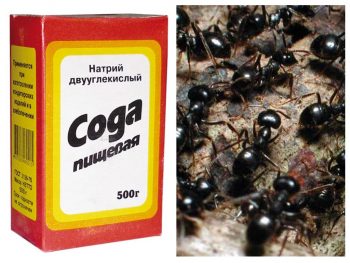
Ammonia
To get rid of ants, ammonia (10% ammonia solution) is used. Ammonia is mixed with water in a ratio of 1:100, i.e. A 100 ml bottle goes for 10 liters of water. In the habitat of ants, it is necessary to remove the top layer of soil at least 5 cm and fill the anthill with the prepared solution. Cover with soil on top. The sharp, specific smell of ammonia will drive away ants for a long time.
Ants don't like semolina
If you sprinkle semolina or millet on an anthill, then after a while the insects will leave this place. 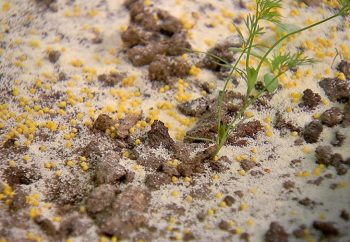
Ground cinnamon and tobacco dust have the same effect on ants.
Boric acid will help get rid of insects
Mix a third of a teaspoon of boric acid with two tablespoons, a tablespoon of sugar and a teaspoon of honey or jam. Place the resulting mixture in plastic caps and place them in areas where the ants move. The result is a bait that the insects eat and take to the queen and the larvae. Boric acid has a detrimental effect on ants, including the queen.
Yeast and sugar
Another effective bait can be prepared by mixing a piece of pressed yeast with a spoonful of sugar. Add a little water until you get a paste. Place the resulting bait near the ant nests. The ants will definitely take the food to the anthill and feed the queen and larvae.
The good thing about the listed folk methods is that their use will not cause serious harm to plants, soil microorganisms and animals.
How to get rid of ants in a greenhouse
To prevent the appearance of ants in the greenhouse, you need to take a number of measures before planting:
- When digging the soil, add ash, lime, ammonium nitrate 20-30g per 1 sq.m.
- Remove old boards, stones, pieces of slate, etc. from the greenhouse. all the garbage under which ants can make their home.
- For 1 liter of water, take 5g of baking soda and 30g of linseed oil and pour the prepared solution onto the soil before planting.
If, after all, ants have moved into the greenhouse, then immediate measures must be taken, because The ant colony multiplies very quickly. You can get rid of ants in a greenhouse in the following ways:
- You need to find the entrance to the anthill and put a napkin on it and pour ammonia on it. Cover the top with a piece of polyethylene to reduce evaporation. All actions must be performed quickly, using a mask and goggles for protection. Leave the greenhouse open for ventilation.
- Mix a teaspoon of boric acid with 100g of minced meat and roll into small balls, which are placed near the anthill. The ants will take the poisoned bait to the anthill. The queen and larvae will die from such a treat. Without a queen, the ant colony will soon cease to exist.
- A good result is obtained by using compressed yeast mixed with honey or jam to a paste-like state. The resulting bait is laid out on lids in the habitats of ants. Insects will not pass by such a treat.
- The anthill can be dug up, placed in a bucket and taken outside the greenhouse. To prevent the ants from scattering during relocation, the edges of the bucket should be coated with sunflower oil. Most likely, you won’t get rid of ants completely in this way, but you will significantly reduce the size of the family.
- It is permissible to use the chemicals Grom-2, Great Warrior, Ant and others described above, but you must strictly adhere to the instructions and follow safety rules.
When dealing with ants, use common sense and precautions and use products that are safe for plants and soil.
You might be interested in:
- How to get rid of wasps in a summer cottage
- How to effectively fight moles
- How to get rid of slugs
- Getting rid of whiteflies in a greenhouse and exhaust gas
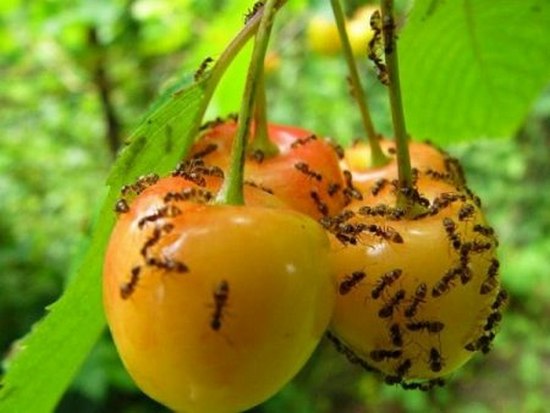
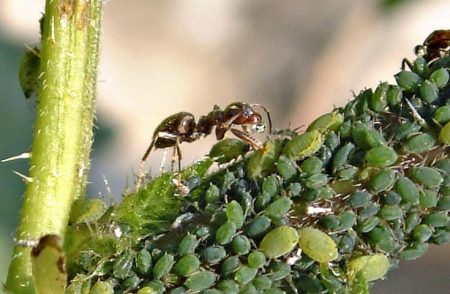
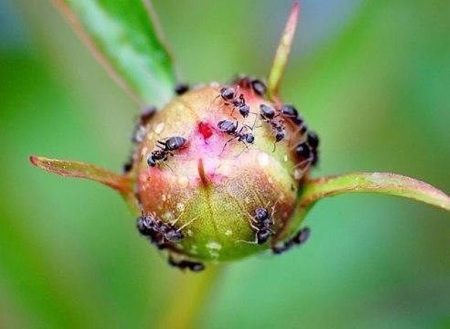
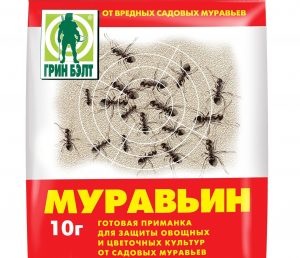
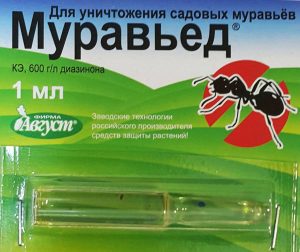
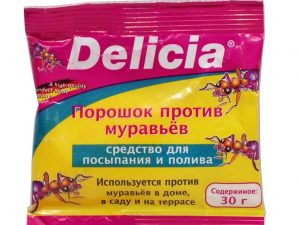
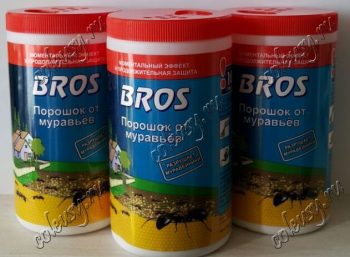
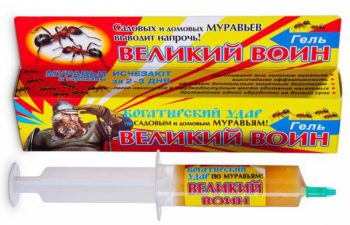
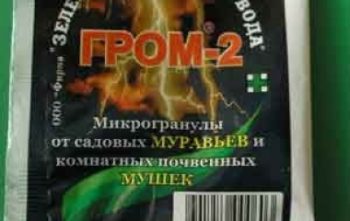
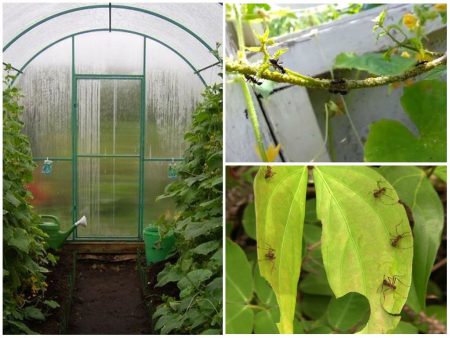


 (3 ratings, average: 3,33 out of 5)
(3 ratings, average: 3,33 out of 5) CUCUMBERS NEVER GET SICK, I'VE BEEN USING ONLY THIS FOR 40 YEARS! I SHARE A SECRET WITH YOU, CUCUMBERS ARE LIKE THE PICTURE!
CUCUMBERS NEVER GET SICK, I'VE BEEN USING ONLY THIS FOR 40 YEARS! I SHARE A SECRET WITH YOU, CUCUMBERS ARE LIKE THE PICTURE! You can dig a bucket of potatoes from each bush. Do you think these are fairy tales? Watch the video
You can dig a bucket of potatoes from each bush. Do you think these are fairy tales? Watch the video
 How our fellow gardeners work in Korea. There is a lot to learn and just fun to watch.
How our fellow gardeners work in Korea. There is a lot to learn and just fun to watch. Eye trainer. The author claims that with daily viewing, vision is restored. They don't charge money for views.
Eye trainer. The author claims that with daily viewing, vision is restored. They don't charge money for views. A 3-ingredient cake recipe in 30 minutes is better than Napoleon. Simple and very tasty.
A 3-ingredient cake recipe in 30 minutes is better than Napoleon. Simple and very tasty. Therapeutic exercises for cervical osteochondrosis. A complete set of exercises.
Therapeutic exercises for cervical osteochondrosis. A complete set of exercises. Which indoor plants match your zodiac sign?
Which indoor plants match your zodiac sign? What about them? Excursion to German dachas.
What about them? Excursion to German dachas.